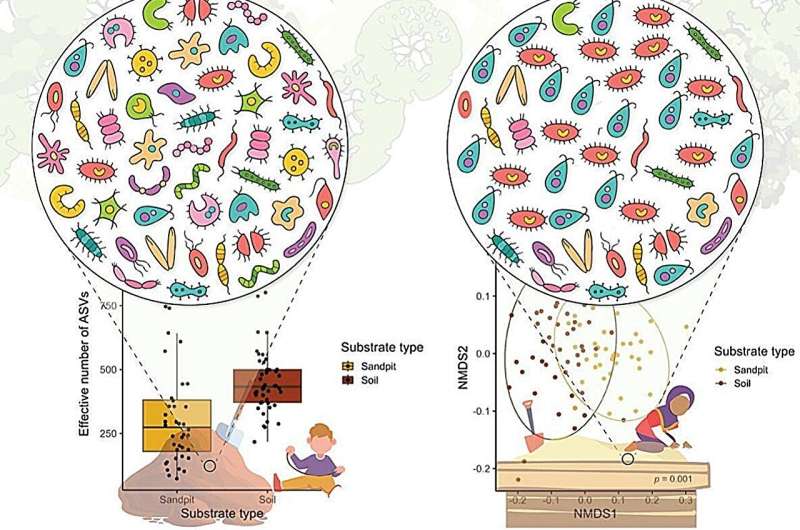This article has been reviewed according to Science X's editorial process and policies. Editors have highlighted the following attributes while ensuring the content's credibility:
fact-checked
peer-reviewed publication
trusted source
proofread
Sandpits or mudpies: Childcare centers can give children a healthy dose of dirt

Exposure to a diverse range of soil bacteria in playgrounds could be a key way for children to boost their immune systems and gut health, according to Flinders University researchers, who put the concept to the test by investigating play areas at 22 childcare centers in Adelaide.
The study found more diverse soil bacteria in well vegetated play areas, highlighting the need for planning more biodiversity in urban environments, says Associate Professor in Biology Martin Breed, lead author of the article published in the journal Science of The Total Environment.
Interestingly, the study also found that the diversity of beneficial microbes was lower in sandpits than in soils—including garden beds, 'mud-play' areas and under lawns.
"We found that sandpits had distinct bacterial communities and lower diversity than soils," says Associate Professor Breed, from the College of Science and Engineering.
"In addition, we found that plant species richness in the centers' yards and habitat condition surrounding the childcare centers influenced the bacterial communities in soils, but not sandpits."
First author Natalie Newman says these results show that the diversity and composition of bacterial communities in sandpits and soils is influenced by surrounding vegetation and depends on the substrate type.
"There is great potential to manage these factors to improve children's exposure to health-associated bacterial communities at a critical time in their immune system development," says Flinders graduate Newman, now an environmental scientist in Adelaide.
It is projected that by 2050, about 70% of the global population will live in urban areas. This transition in human population has reduced our engagement with naturally biodiverse environments. This reduced "dose of nature" has resulted in negative health consequences, including weaker immune systems which have been associated with increasing rates of asthma and even anxiety.
Co-author Dr. Jake Robinson, also from the Flinders University College of Science and Engineering, says there is mounting evidence to support connections between human health and exposure to environmental typologies such as green and blue, aquatic spaces.
"However, the mechanistic links that connect human health with biodiversity are less clear," says Dr. Robinson.
"We are seeking more evidence and possible frameworks to map the links between biodiversity and our health."
Researchers say there is a need for improved policies that promote retaining native biodiversity and restoring ecosystems as a public health intervention.
"This should include greater consideration of integrating the health benefits from biodiversity when implementing nature-based solutions and promoting reciprocity with the land," they say.
More information: Natalie S. Newman et al, Childcare centre soil microbiomes are influenced by substrate type and surrounding vegetation condition, Science of The Total Environment (2024). DOI: 10.1016/j.scitotenv.2024.172158




















